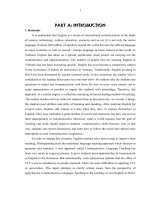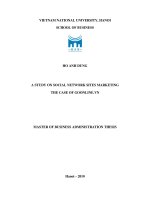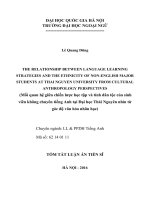A study on common errors related to the usage of DO and MAKE collocations by English non-major students at Thai Nguyen University of Economics and Business Administration (TUEBA)
Bạn đang xem bản rút gọn của tài liệu. Xem và tải ngay bản đầy đủ của tài liệu tại đây (183.91 KB, 3 trang )
A study on common errors related to the usage of
DO and MAKE collocations by English non-
major students at Thai Nguyen University of
Economics and Business Administration
(TUEBA)
Phạm Thị Ngà
Trường Đại học Ngoại ngữ
Luận văn Thạc sĩ ngành: English linguistics; Mã số: 60 22 15
Người hướng dẫn: Assoc. Prof. Dr. Võ Đại Quang
Năm bảo vệ: 2012
Abstract. The students at Thai Nguyen University of Economics and Business
Administration as EFL learners often use uncommon phrasing patterns which make native
English speakers find it harder to understand. This thesis investigated common errors
occurred when the student used collocations with DO and MAKE in the “verb + noun”
pattern. Three types of tests were employed as the data collection instruments. The results
collected from the students’ tests represented the current state of error types as well as
confirmed the low vocabulary proficiency among students. It was found that errors were
made when students did not understand the constituents of the collocations. Studying
another type of error in different patterns could be necessary for future research.
Keywords. Ngôn ngữ; Tiếng Anh; Ngữ pháp
Content
1. Rationale of the study
“No piece of natural spoken or written English is totally free of collocation” (OCD, 2009).
Therefore, learning collocation is important for EFL learners. For students, choosing the right
collocation will make his/her speech and writing sound much more natural, more native-speaker-
like. Poor collocation in exams is also likely to lead to lower marks. However, during the time
working as a teacher of English at Thai Nguyen University of Economics and Business
Administration (TUEBA), I have found out that English non- major students at different levels
often make mistakes in using DO and MAKE collocations. For this reason, I decided to choose this
as the theme for my MA thesis.
2. Aims and objectives of the study
The ultimate purposes of the research are:
i. To help English non-major students gain an insight into DO and MAKE collocations.
ii. To examine the influenced factors to possible errors made by the students
iii. To improve my own teaching of English at TUEBA
To achieve these aims, the following objectives are pursued forward:
Establishing the types of errors related to DO and MAKE collocations commonly
committed by English non-major students at TUEBA
Finding out the causes of students’ errors related to the usage of DO and MAKE
collocations.
Working out possible solutions to the problems encountered by students in using
collocations with DO and MAKE.
3. Scope of the study
The survey was conducted at TUEBA. The population was not large, only 300 Accounting students
who were at pre-intermediate level of English. Only errors related to the uses of DO and MAKE
collocations in the form of “verb + noun” pattern were taken into consideration.
4. Significance of the study
It is much to the author’s expectation that the research results will help students gain a more
insightful look into English MAKE and DO collocations. And, on account of this, well-formed
utterances containing DO and MAKE collocations might be produced. And, this constitutes the
practical value of the research.
5. Structure of the thesis
The thesis consists of three main parts: Part A, B and C. Part A is an introduction that gives a
rationale behind the study. It also presents the aims, objectives, the significance as well as scope of
the study. Part B is divided into three chapters; chapter 1 both reviewed some previous studies
related to the research area of the thesis and provides theoretical background to the concerning
matters. In chapter 2, the methodology of the thesis including research-governing principles and
research methods are introduced. Chapter 3 analyzes data collected from the students’ tests.
Additionally, some significant findings of the study are written up and discussed.
Part C concludes the main issues which dealt with in the previous parts. Accordingly, some
concluding remarks are drawn out.
References
Aisenstadt, E. (1979), Collocability restrictions in dictionaries, University of Exeter, Exeter. pp.
71-74.
Bahn, J. (1993), “Lexical Collocations: A Contrastive View”, ELT Journal, 47(1), pp.57.
Bahns, J. and Eldaw, M. (1990), “Should we teach EFL students collocations?” Paper given at 9
th
World Congress of Applied Linguistics, ThessalonikiCambridge, Cambridge University Press, pp.
27-36.
Bahns, J. and Eldaw, M. (1993), “Should we teach EFL students collocations?” System, 21(1), pp.
101-114.
Cambridge Advanced Learners’ Dictionary (2005), CUP, Cambridge.
Channell, J. (1981), “Applying semantic theory into vocabulary teaching”. ELT Journal, 35 (1),
pp.115-122.
Cruse, D. (1986), Lexical Semantics, CUP, Cambridge.
Elyildirm, S. (1998), “The acquisition of collocation by Turkish EFL learners”. (Unpublished
doctoral dissertation), University of Reading, Reading, United Kingdom.
Firth, J. (1957), “Modes of meaning”: In F. Palmer (ed.), Papers in linguistics, pp. 190-215,
London.
Granger, S. (1998), Prefabricated patterns in Advanced EFL writing: collocations and formulae in
A. P. Cowie (ed.), Phraeology, theory, analysis and applications, Clarendon Press, Oxford, pp. 145-
160.
Halliday, M. (1966), Lexis as a linguistic level, Longman, London. pp. 148- 162.
Koya, T. (2005), The acquisition of basic collocations by Japanese learners of English, Doctoral
dissertation, Waseda University.
Lee C.Y. (2010), “A study of collocation behaviors on lexical pragmatics”. Asian EFL Journal,
4(10), pp. 102-113.
Levy, P. S., & Lemeshow, S. (1999), Sampling of populations: Methods and applications (3rd ed.),
John Wiley and Sons, New York.
Marton, D. M. (1977), Research methods in education and psychology: Integrating diversity with
quantitative & qualitative approaches, CA: Sage Publications, Inc.
Martynska, M. (2004), “Do English language learners know collocations?” Investigation
Linguistics, 11(1), pp. 1-12.
Matsuno and Sugiura (2002), The Acquisition of Basic Collocations by Japanese Learners of
English, Nagoya University.
McCarthy, M. & O’dell, F. (2005), Collocations in Use, Cambridge University Press, Cambridge.
McIntosh, C. et al. (2009), Oxford Collocations Dictionary for Students of English. OUP, Oxford.
Moon, R. (1997), Vocabulary connections: multi-word items in English. In N. Schmitt &
McCarthy, M. (Eds.) Vocabulary: Description, Acquisition and Pedagogy, pp: 40-63. Cambridge
University Press, Cambridge.
Nesselhauf, N. (2003), “The use of collocations by advanced learners of English and some
implications for teaching”, Applied Linguistics, 24(2), pp. 223-242.
Palmer, H. E. (1933), Second Interim Report on English Collocations, Submitted to the Tenth
Annual Conference of English Teachers under the Auspices of the Institute for Research in English
Teaching, Institute for Research in English Teaching, Tokyo.
Salant, P., &Dillman, D. A. (1994), How to conduct your own survey, John Wiley and Sons, New
York.
Sterkenburg, P. G. J. Van. (2003), A practical guide to lexicography, Amsterdam.









